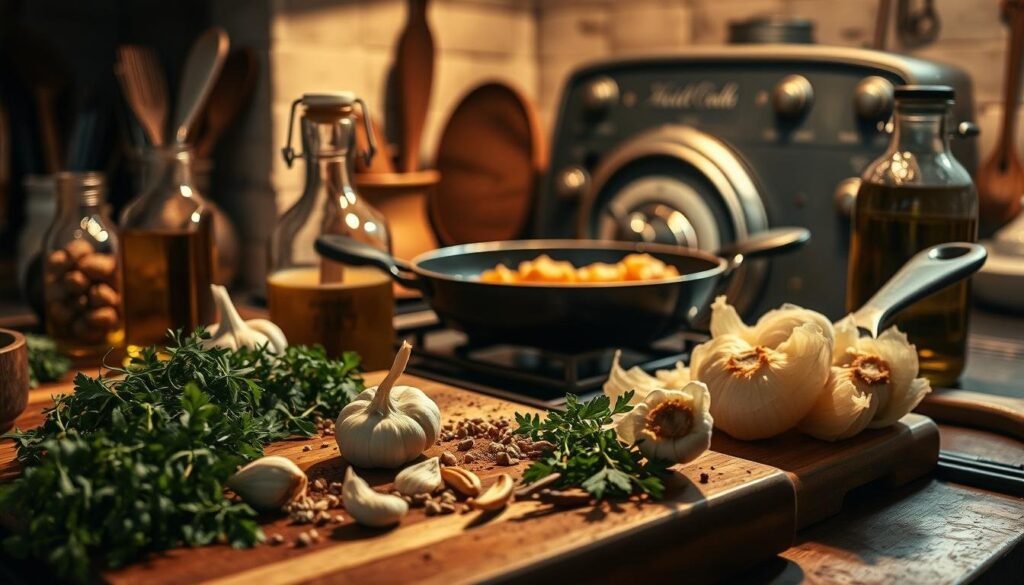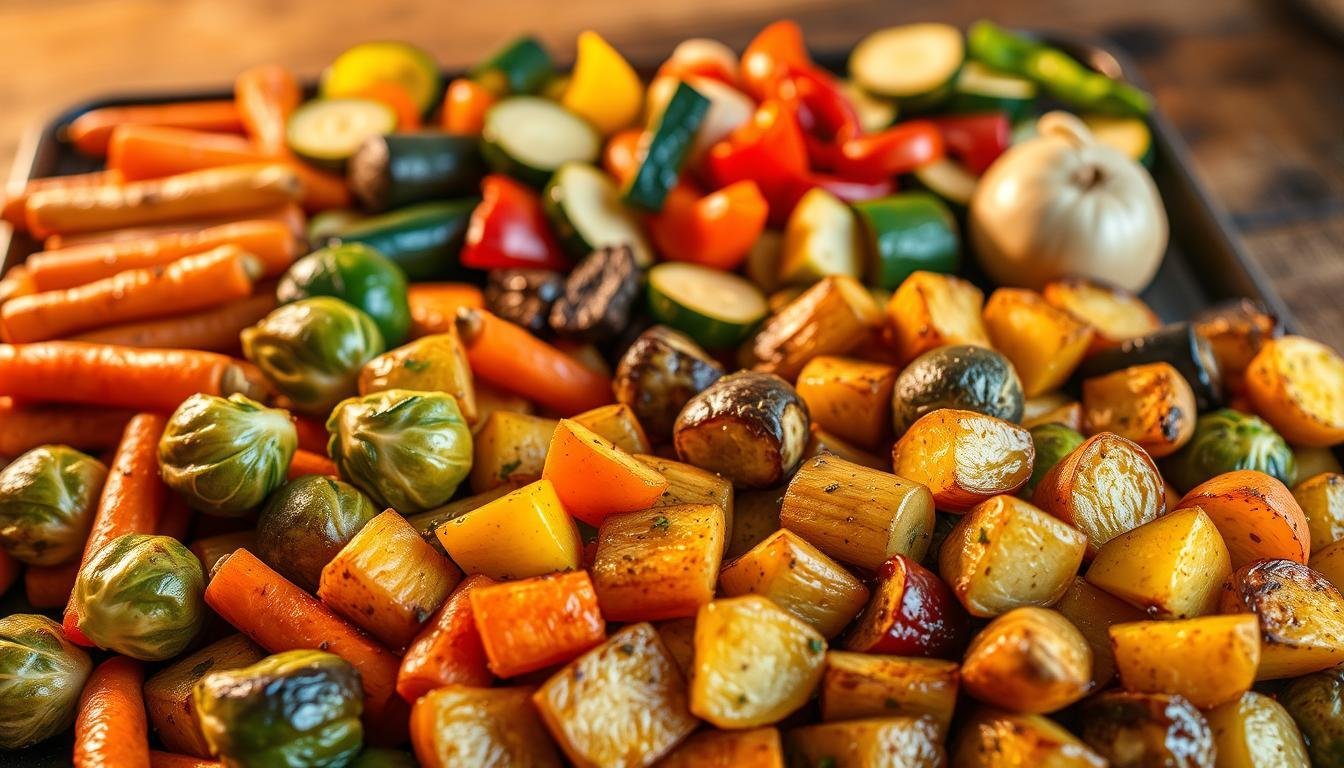Last updated on October 18th, 2025 at 04:24 pm
Slow Cook Vegetables in Oven: Turning your side dishes into tender, flavorful wonders is simpler than you might think. By using gentle heat, you can make mouth-watering vegetable dishes that go great with any meal.
Oven roasting brings out the natural sweetness in veggies, making them taste better and feel softer. To get perfectly cooked veggies, knowing the secrets of effective slow cooking is key.
With the right steps, even the simplest veggies can become tender, delicious sides that wow everyone. In this guide, we’ll share the secrets to making your veggies tender and full of flavor.
Contents
- 1 The Magic of Slow-Roasted Vegetables
- 2 Essential Equipment for Oven Slow Cooking
- 3 Preparing Vegetables for Slow Roasting
- 4 Perfect Temperature and Timing Guidelines
- 5 Essential Slow Cook Vegetables in Oven Tips
- 6 Flavor-Enhancing Ingredients and Techniques
- 7 Vegetable-Specific Slow Roasting Guide
- 8 Conclusion: Slow Cook Vegetables in Oven
- 9 FAQ
- 9.1 What are the benefits of slow cooking vegetables in the oven?
- 9.2 What equipment do I need to slow cook vegetables in the oven?
- 9.3 How do I prepare vegetables for slow roasting?
- 9.4 What is the optimal temperature for slow roasting vegetables?
- 9.5 How do I check if slow-roasted vegetables are done?
- 9.6 Can I slow cook different types of vegetables together?
- 9.7 How can I enhance the flavor of slow-roasted vegetables?
- 9.8 What are some common mistakes to avoid when slow cooking vegetables in the oven?
The Magic of Slow-Roasted Vegetables
Slow roasting is a magic trick that turns vegetables into tender treats. It cooks them at a low temperature for a long time. This breaks down their cell walls, making them tender and flavorful.
The science behind slow roasting is the Maillard reaction. It’s a chemical reaction between amino acids and sugars when food is cooked. This reaction creates new flavor compounds, enhancing the vegetables’ natural taste.
Root vegetables like carrots and parsnips are great for slow roasting. So are Brussels sprouts and broccoli. They become tender and caramelized, with a rich flavor that’s hard to get with other cooking methods.
| Vegetable | Roasting Time | Result |
|---|---|---|
| Carrots | 45 minutes | Tender and caramelized |
| Brussels Sprouts | 30-40 minutes | Crispy exterior, tender interior |
| Broccoli | 20-30 minutes | Tender and slightly caramelized |
Essential Equipment for Oven Slow Cooking
For successful oven roasting, having the right cooking gear is crucial. To slow cook vegetables effectively, you’ll need a few essential items.
- Baking sheets for spreading out vegetables in a single layer
- Roasting pans for deeper vegetables or for creating a richer flavor
- Parchment paper or silicone mats for easy cleanup
Using the right equipment ensures even cooking and prevents vegetables from becoming too messy. For instance, baking sheets allow for air circulation around the vegetables, promoting even roasting.
By investing in the right cooking equipment, you’ll be able to achieve perfectly cooked, flavorful vegetables every time. [Slow Cook Vegetables in Oven]
Preparing Vegetables for Slow Roasting
Getting your vegetables ready for slow roasting is key. It involves a few steps to make them tender and tasty.
Start by washing your veggies well to get rid of dirt. Then, peel them if needed and cut them into the same size pieces. Uniformity is key to ensure all parts cook evenly.
| Vegetable | Peeling Required | Chopping Size |
|---|---|---|
| Carrots | Yes | 1-inch sticks |
| Potatoes | Yes | 1-inch cubes |
| Brussels Sprouts | No | Halved |
Once chopped, season your veggies with herbs and spices. Mix well to coat them evenly. [Slow Cook Vegetables in Oven]
Perfect Temperature and Timing Guidelines
The secret to tasty slow-cooked veggies is knowing the best oven temperature and cooking time. A lower temperature (275°F to 300°F) is best for slow roasting. It cooks veggies evenly and keeps their natural flavors.
Visual Cues for Doneness
Look for visual signs to check if veggies are done. They should be tender and lightly browned on the outside. For instance, carrots are ready when they turn deep orange and have a slightly wrinkled skin.
Texture testing is also a good way to check for doneness. Use a fork to test the veggies; they should be tender but not too soft. Below is a table with texture and visual cues for common veggies.
| Vegetable | Texture Cue | Visual Cue |
|---|---|---|
| Carrots | Tender, not hard | Deep orange, slightly wrinkled |
| Broccoli | Soft, but crisp stems | Florets are tender, slightly browned |
| Brussels Sprouts | Tender, slight give | Caramelized, slightly browned |
By using the right temperature, timing, and doneness checks, you can make perfectly slow-cooked veggies every time. [Slow Cook Vegetables in Oven]
Essential Slow Cook Vegetables in Oven Tips
Delicious slow-cooked vegetables start with a few key oven roasting techniques. First, avoid overcooking to prevent mushy veggies. Keep an eye on the temperature and adjust cooking time for different veggies.
Don’t overcrowd the baking sheet to prevent steaming. Give veggies enough space for even browning and caramelization. Proper air circulation is crucial for that perfect roast.
| Vegetable | Temperature (°F) | Cooking Time (minutes) |
|---|---|---|
| Carrots | 425 | 20-25 |
| Brussels Sprouts | 400 | 25-30 |
| Broccoli | 425 | 15-20 |
Follow these tips and techniques for tender, flavorful veggies. Be patient and adjust cooking methods for each veggie. [Slow Cook Vegetables in Oven]
Flavor-Enhancing Ingredients and Techniques
Improving the taste of your slow-roasted vegetables is easy with a few simple steps. The right ingredients are crucial to enhance their natural flavors.
Start with herbs and spices. Fresh or dried herbs like thyme, rosemary, or oregano add depth. Spices like cumin, paprika, or chili powder can also boost the flavor.

Acids like lemon juice or vinegar brighten the taste. Umami-rich ingredients like soy sauce or miso paste add a savory touch. Aromatics like garlic and onions caramelize, adding a sweet flavor.
By mixing these ingredients and techniques, you can make delicious slow-roasted vegetables. Try different combinations to find your favorite. [Slow Cook Vegetables in Oven]
Vegetable-Specific Slow Roasting Guide
Mastering slow-roasted vegetables starts with knowing each type’s needs. Different veggies need different temperatures, cooking times, and prep methods. This ensures they taste and feel their best.
Root veggies like carrots and parsnips do well at 275°F for 45-60 minutes. This slow cooking makes them sweet and tender. Leafy greens, like kale and spinach, roast best at 400°F for 5-10 minutes. This quick heat keeps their nutrients and color bright.
Broccoli and cauliflower fall in the middle, roasting at 325°F for 20-30 minutes. Remember to toss them halfway to get a nice brown color all over.
| Vegetable Category | Temperature (°F) | Cooking Time (minutes) | Special Tips |
|---|---|---|---|
| Root Vegetables | 275 | 45-60 | Peel and chop into uniform pieces for even cooking. |
| Leafy Greens | 400 | 5-10 | Toss with olive oil, salt, and pepper; watch closely to avoid burning. |
| Cruciferous Vegetables | 325 | 20-30 | Toss halfway through cooking for even browning. |
By using these tips, you’ll get perfect slow-roasted veggies every time. You’ll enjoy the full flavor of each vegetable. [Slow Cook Vegetables in Oven]
Conclusion: Slow Cook Vegetables in Oven
You now know how to make tasty, tender sides by slow cooking veggies in your oven. Just follow the tips in this article to get perfectly roasted veggies every time. Learning to slow cook means knowing the right temperature, timing, and techniques to enhance your veggies’ flavors.
Want to make your slow-cooked sides even better? Try different veggies and flavors together. Mix root veggies like carrots and parsnips with herbs like thyme and rosemary. Or, roast Brussels sprouts with balsamic glaze. The secret to tender sides is cooking them low and slow, so they soak up all the flavors and get tender and caramelized.
With more practice, you’ll get good at making many tender sides that go great with any meal. So, don’t hesitate to try new recipes. By mastering slow cooking, you’ll add a new twist to your cooking. You’ll impress your family and friends with your delicious, tender sides.
See Also: Can You Put a Crock Pot in the Oven?
FAQ
What are the benefits of slow cooking vegetables in the oven?
Slow cooking vegetables in the oven makes them tender and flavorful. It breaks down their cell walls. This results in caramelized and deliciously textured veggies.
What equipment do I need to slow cook vegetables in the oven?
You’ll need baking sheets, roasting pans, and parchment paper. These tools ensure even cooking and make cleanup easy. [Slow Cook Vegetables in Oven]
How do I prepare vegetables for slow roasting?
First, wash, peel, chop, and season the veggies. Make sure cuts are uniform for even cooking. Pre-seasoning boosts flavor.
What is the optimal temperature for slow roasting vegetables?
The best temperature for slow roasting varies by vegetable type. But, it’s usually a low temperature. This helps break down cell walls for tender results.
How do I check if slow-roasted vegetables are done?
Check for visual cues like caramelization. Also, use texture testing, like fork tenderness, to see if they’re done. [Slow Cook Vegetables in Oven]
Can I slow cook different types of vegetables together?
Yes, you can cook different veggies together. Just adjust cooking times and temperatures for each type and size for the best results.
How can I enhance the flavor of slow-roasted vegetables?
Use herbs, spices, acids like lemon juice, and umami-rich ingredients. Aromatics like garlic and onions add depth to the roasted veggies.
What are some common mistakes to avoid when slow cooking vegetables in the oven?
Avoid overcrowding the baking sheet and overcooking. Also, don’t forget to adjust cooking times based on the type and size of the veggies.

Hi, I’m Leland Benson from Los Angeles. I studied marketing and worked 5 years at LG, selling ovens. From my job, I learned what things are safe to put in ovens. Now, I share simple advice to help you cook safely.

